
Euphorbia is a very large and diverse genus of flowering plants, commonly called spurge, in the family Euphorbiaceae. "Euphorbia" is sometimes used in ordinary English to collectively refer to all members of Euphorbiaceae, not just to members of the genus.

The poinsettia is a commercially important flowering plant species of the diverse spurge family Euphorbiaceae. Indigenous to Mexico and Central America, the poinsettia was first described by Europeans in 1834. It is particularly well known for its red and green foliage and is widely used in Christmas floral displays. It derives its common English name from Joel Roberts Poinsett, the first United States minister to Mexico, who is credited with introducing the plant to the US in the 1820s. Poinsettias are shrubs or small trees, with heights of 0.6 to 4 m. Though often stated to be highly toxic, the poinsettia is not dangerous to pets or children. Exposure to the plant, even consumption, most often results in no effect, though it can cause nausea, vomiting, or diarrhea.

Chamaesyce is a subgenus of plants in the family Euphorbiaceae. Recent phylogenetic studies have shown that Chamaesyce is deeply nested within the broader Euphorbia. Specifically, Chamaesyce is very closely related to plants like Euphorbia pulcherrima, the popular poinsettia. Currently, all species have now been reclassified as species of Euphorbia. Specifically, this group now belongs to Euphorbia subgenus Chamaesyce section Anisophyllum. Taxonomically speaking, Chamaesyce is considered a synonym of Euphorbia.

Euphorbia albomarginata, whitemargin sandmat or rattlesnake weed, is a small low-growing perennial, in the spurge family native to desert, chaparral, and grassland habitats of southwestern North America, from southern and central California to Northern Mexico and Louisiana.

Euphorbia corollata is an herbaceous perennial plant in the family Euphorbiaceae that is native to North America. A common name for the species is flowering spurge. It has a milky sap that can cause skin and eye irritation in some people. It grows up to 1 m (3 ft) tall, with smooth stems and light green leaves arranged alternately or in whorls. Leaves are about 10 mm wide and 75 mm (3 in) long. Each stem terminates in a panicle 20 to 25 mm across. Flowers are about 6 mm across and consist of one pistillate and several staminate flowers surrounded by five white bracts - not petals but formed from the involucre at the base of the flowers. Flowering spurge blooms from June to September.

Euphorbia eriantha is a species of spurge known by the common name beetle spurge. It is also called the Desert Poinsettia and Mexican Poinsettia. It is native to the deserts of northern Mexico and the southwestern United States from California to Texas. Its flowering season is from February to October in Arizona; March to April in California; January to December in Texas.This is an annual herb reaching anywhere from 15 to 50 centimeters in height. The leaves are long, narrow, and pointed, sometimes with sparse hairs, and 2 to 7 centimeters long. The foliage may be dark in color, from greenish to purplish or reddish. The inflorescence appears at the tip of the branch and contains staminate or pistillate flowers which are just a few millimeters wide. The fruit is an oblong, hairy capsule half a centimeter long, with gray and black mottling. It contains bumpy white or gray seeds.
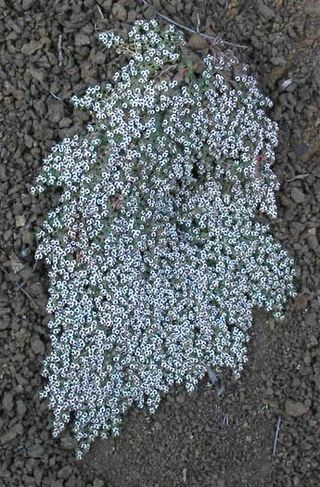
Euphorbia polycarpa is a species of spurge known by the common name smallseed sandmat. It is native to the southwestern United States and northern Mexico, especially the deserts and other dry, sandy areas. This is a perennial herb producing stems that trail along the ground to form a clump or mat, sometimes growing somewhat upright. The leaves are each under a centimeter long. They are round or oval-shaped and have triangular stipules at the bases. What looks like a single flower is actually an inflorescence of many staminate (male) flowers united around a single central pistillate (female) flower. Bracts surrounding the flower unit are white and petal-like. The fruit is a thin spherical capsule less than 2 millimeters wide layered over a seed.
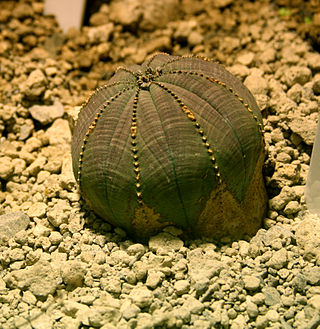
Euphorbia obesa is a subtropical succulent species of flowering plant in the genus Euphorbia. It comes from the south-central Cape Provinces of South Africa. Sometimes referred to as the baseball plant.

Euphorbia marginata is a small annual in the spurge family.

Euphorbia nutans is a species of Euphorbia known by the common names eyebane and nodding spurge. It is native to much of the United States, Eastern Canada, Mexico, Central America, the Caribbean, and Venezuela.

Euphorbia prostrata is a species of spurge known by the common name prostrate spurge or prostrate sandmat.
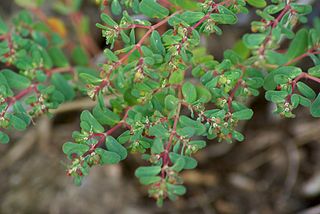
Euphorbia serpyllifolia is a species of euphorb known by the common names thymeleaf sandmat or thyme-leafed spurge. It is native to a large part of North America from Canada to Mexico, where it is a common member of the flora in many types of habitat. This is an annual herb growing as a prostrate mat or taking a somewhat erect form. The oblong leaves are up to about 1.5 centimeters long, sometimes hairy and finely toothed along the edges. The tiny inflorescence is a cyathium about a millimeter wide. It bears scalloped white petal-like appendages arranged around the actual flowers. At the center are several male flowers and one female flower, which develops into a lobed, oval fruit up to 2 millimeters wide. This plant had a number of traditional medicinal uses for many Native American groups.

Euphorbia schizoloba is a species of euphorb known by the common name Mojave spurge. It is native to the southwestern United States, where it grows in desert hills and mountains. It is a perennial herb producing upright stems up to 40 centimeters tall, sometimes with coats of sparse hairs. The stems are lined with alternately arranged leaves which are oval with pointed tips and measure up to 2 centimeters in length. The inflorescence is a cyathium with bell-shaped bracts surrounding four tiny glands with flat, fringed appendages. At the center of this arrangement are several staminate flowers and one long pistillate flower.

Thalictrum fendleri is a species of flowering plant in the buttercup family known by the common name Fendler's meadow-rue. It is named in honor of Augustus Fendler.

Hesperidanthus argillaceus, syn. Schoenocrambe argillacea, is a species of flowering plant in the mustard family, known by the common names clay reed-mustard, Uinta Basin plainsmustard, and clay thelypody.

Calamoideae is a subfamily of flowering plant in the palm family found throughout Central America, South America, Africa, India, China, Southeast Asia and Australia. It is represented by 21 genera - containing nearly a quarter of all species in the palm family - including the largest genus, Calamus, the type genus of the group. Only four are found in the New World while the rest are Old World denizens, usually found in equatorial swampland or along tropical coastlines.
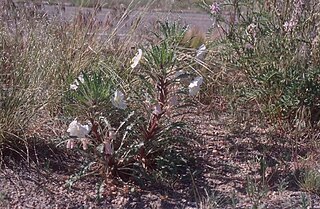
Oenothera harringtonii is a species of flowering plant in the evening primrose family known by the common names Arkansas Valley evening primrose and Colorado Springs evening primrose. It is endemic to the state of Colorado in the United States.
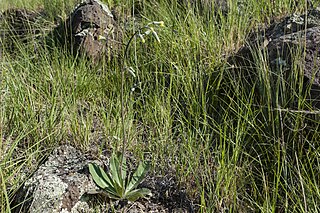
Hieracium fendleri is a North American plant species in the tribe Cichorieae within the family Asteraceae. It is widespread across much of the western part of the continent, from the Black Hills of Wyoming and South Dakota south as far as Guatemala.
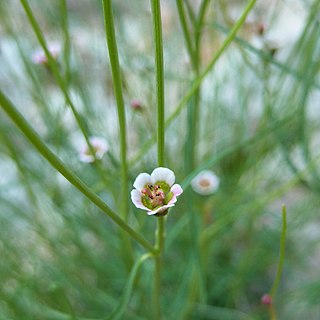
Euphorbia aaron-rossii, also known as the Marble Canyon spurge, is a perennial, herbaceous plant species of Euphorbia native to Arizona. It's most closely related to E. strictior and E. wrightii, but needs more study.

Noccaea fendleri more commonly known as wild candytuft and alpine pennycress is a wildflower in the mustard family from western North America. It grows in mountains from northern Mexico to the northern United States. It blooms early in the spring and provides nectar to butterflies.





















